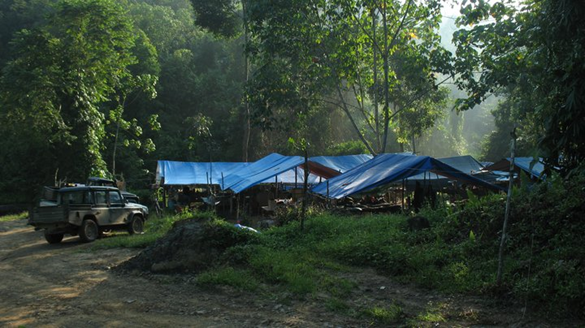Natalie Yoh and Dave Seaman discuss their recently published research article that uses remote sensing to investigate the effects of logging on aerial insectivorous bats in Southeast Asia. Findings indicate that logged forests can provide an important refuge and several species that respond predictably to logging could be targeted for biodiversity monitoring using acoustic and capture-based methods.
“Bats make up around 40% of Borneo’s mammal species,
representing more species than all of Borneo’s
primates, cats, and civets combined.”
Logging in tropical forests
Walking through lowland tropical forests in Borneo can be a breathtaking experience, even when those forests have been disturbed. Selective logging – the removal of specific, high-value trees while leaving other trees largely untouched – is a common logging method in the tropics. Although this process does cause noticeable damage, what is left behind by the loggers is still unmistakeably a forest. These disturbed forests may not be the intact, cathedral-like, primary forests with trees towering 80 metres plus overhead, but they are still home to high numbers of species.
Forgotten species
Some species, like orangutans (Pongo pygmaeus), are relatively well-studied in these disturbed forests. Yet little is known about others. Bats make up around 40% of Borneo’s mammal species, representing more species than all of Borneo’s primates, cats, and civets combined. Therefore, it is vital they are not overlooked when we determine how logging is impacting wildlife. Typically small and nocturnal, they can be difficult to survey, especially species that use echolocation to navigate their surroundings (which is the vast majority!). Echolocation calls help them navigate through forests and detect insects, and also help them detect and evade traps. There are also many species which fly high above the canopy – well out of reach of most survey methods.

Monitoring from a distance
However, we can use their echolocation to our advantage by using acoustic detectors to listen out for these calls. In our study, we set up a network of detectors in intact forest, lightly logged forest, heavily logged forest, and neighbouring Acacia plantations. Step one was to determine how species (or species groups) were using each habitat. For example, we found Ridley’s leaf-nosed bat (Hipposideros ridleyi) in both undisturbed forest and lightly logged forest but not in the more disturbed habitats. However, we also wanted to know why.

What drives these patterns? Is it because there’s more vegetation in the understory? Is it because the canopy is shorter or more open? To capture how logging affects the forest, we used a type of remote sensing data called LiDAR (or light detection and ranging).
LiDAR works a bit like a bat’s echolocation but using light rather than sound. A laser is used to build a profile of the forest from ground to canopy by measuring forest characteristics based on how the laser is reflected. A key benefit of using acoustic monitoring and LiDAR is that we were able to collect data over a large area, for many months at a time, with minimal additional disturbance to the forest or the bats themselves.
The verdict
Using this approach, we found that – like for many other tropical forest-dependant species – logged forests provide important habitat for Borneo’s bats. For the majority of species, the most important factor was the amount of forest, not necessarily the disturbance.
Conversely, unlike these logging concessions, we found forest bats were not able to live in plantations. As logging provides a financial incentive to protect areas of forest that may otherwise have been cut down to make way for plantations, we should recognise logging concessions as important habitat for many species and ensure they are well managed.

However, there are some important exceptions. Species like Ridley’s leaf-nosed bat are highly specialised for living in intact forest and cannot necessarily adapt to living in new conditions in forests disturbed by logging. Therefore, it is still important we also maintain areas of intact forest, free from disturbance, to help conserve the most vulnerable species.
Nevertheless, we can thank logging concessions for providing habitat to a large number of Borneo’s least understood and most abundant mammals.
Read the full Open Access article, “Benign effects of logging on aerial insectivorous bats in Southeast Asia revealed by remote sensing technologies“ in Journal of Applied Ecology


